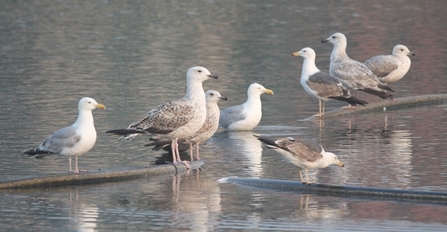
Gulls at Woodberry - Chris Farthing
Woodberry Wetlands - image by Hadi El Ali

Gulls at Woodberry - Chris Farthing
June here is mostly concerned with breeding activity, which means that unusual birds are generally hard to come by. Hopes do rise slightly towards the end of the month as chances of early migrants returning south increase, possibly after a failed breeding cycle. This has resulted in a few wading birds being seen here over the years in late June, but unfortunately this June wasn’t one of them.
There was a bit of interest amongst the gulls. On the 12th, a second calendar year great black-backed gull (2nd bird from the left in main photo above) was seen on the gull pipes, towering over the regular lesser black-backed and herring gulls which would usually be considered ‘large gulls’. This species is probably seen here around a handful of times each year. The second gull highlight featured a foreign visitor. Woodberry is a regular over-wintering site for black-headed gulls, with several hundred often present in the winter. However, these gulls don’t stay to breed here, but disperse far and wide around the UK and mainland Europe. Occasionally a gull with a darvic ring (a coloured plastic ring bearing a code, designed to be read in the field rather than by recapturing the bird) is spotted and often reveals an interesting story. On the 29th, a black-headed gull (picture 1 below) with a coded ring reading TXJY was seen on one of the posts around the lagoons. Looking up details online revealed that the bird was ringed as an adult at Przykona reservoir, close to the town of Turek in central Poland in 2017. It overwinters in the UK, usually at Ruislip Lido, and returns to Poland to breed in the summer.

Black-headed gull and common tern - Chris Farthing
Common terns (2) provided a regular highlight through June, birds visiting almost every day, with a maximum count of five birds being seen. The birds are likely to have come from the Walthamstow Wetlands breeding colony.
Waterfowl spent June quietly getting on with breeding, and the only unusual visitors were a pair of shoveler seen on the 15th. Little egrets (3) were seen most days in June, particularly towards the end as the young birds fledged from the Walthamstow heronry.
Red kites have been seen in the London area more often in 2020 than any preceding year and we had another couple of sightings here in June, in additional to the regular sparrowhawks and peregrines.

Little egret and whitethroat - Chris Farthing
Swifts were a constant presence throughout June, with around 50 birds often being seen. A few records each of sand martin and house martin were also noted. Amongst non-breeding passerine birds, there were the occasional record of both whitethroat (4) and garden warbler.
The total number of bird species seen here in June was 63, which is a slightly better total than each of the previous three years, but well behind the remarkable June of 2016 when the total was 69.
[Photos by Chris Farthing]